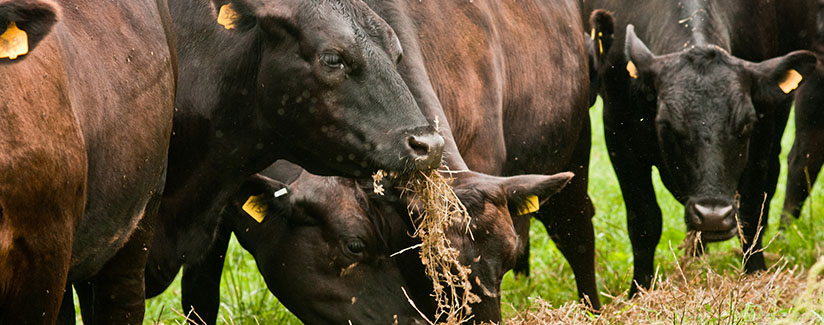
What Do Cows Eat?
Ever wonder what went into the steak that winds up on your dinner table? It’s common knowledge that corn is a dietary staple for food animals, but what else do they eat? We contacted Dr. Danelle Bickett-Weddle, lecturer and associate director at the Center for Food Security and Public Health, Iowa State University, to find out more.
What, in general, are diets of beef cattle comprised of?
Dr. Bickett-Weddle: “The common ingredient across all beef cattle diets is grain – typically corn or corn products – as it is an excellent source of energy (calories) for animals. However, different animal species have different digestive systems and can utilize other feedstuffs for energy, protein, vitamins and minerals. As living beings, animals have a daily requirement for energy, protein, vitamins and minerals. Animals such as cattle, sheep, goats and bison are called ruminants, which means their stomachs have multiple compartments to facilitate their unusual digestive system (more on this later). These animals can utilize forages like hay, corn silage and oat silage as an energy and protein source. Silage is created by harvesting a crop while it is still green, chopping it finely and packing it tightly in a silo for storage. Protein sources for all animals can also come from soybeans, canola, sunflowers and many other plants. Those also provide essential amino acids that animals need for growth and development. Vitamins and minerals come from natural plant sources, organic sources (limestone, bicarbonate), and many other supplements, much like people meet their daily vitamin and mineral requirements.”
We saw a report about cows eating candy. Should consumers be concerned about the use of alternative ingredients such as candy and baked goods in these diets?
Dr. Bickett-Weddle: “Candy and other baked goods provide an energy source for animals, just like they do for people. However, it is the balance of those energy sources with the right amount of protein and minerals that ensures animals meet their daily requirements for growth and development. Just like too much candy on Halloween upsets a child’s stomach (or their parents’!), too much of one thing in an animal’s diet can have the same effect. That is why so much care goes into growing feed, harvesting it at the right time, and offering a balance of different nutrients to our animals to meet their needs.
How animals digest feed is different than humans – let’s look at the digestive tract of cattle for instance. They have a four-compartment stomach, of which the biggest section is the rumen. The rumen is an amazing digestion environment – think of it as a fermentation vat, much like what is used to brew beer or whiskey. The rumen has millions of living microbes in it that need to be fed. Rumen microbes can utilize a variety of sugars, such as the fines from cereal production or whole candy bars, that would otherwise be a waste product filling up our landfills. Their rumen microbes turn it into sugar that can be utilized by their body for growth and development. Those microbes require a balance of feedstuffs though – they also need forages and protein. It is the byproducts of rumen microbe digestion of forages, sugars, grains, starches, and proteins that provide the essential nutrients a cow or other ruminant (sheep, goats, bison) needs for energy and growth.
Much like a master brewer needs to ensure there is the right mixture of yeast and sugars, a farmer ensures the animals receive the right balance of feed ingredients for proper muscle development.”
Are there regulations covering what can be fed to animals raised for food?
Dr. Bickett-Weddle: “Yes, there are regulations on animal feed. The U.S. Food and Drug Administration is in charge of inspecting feed mills to ensure quality ingredients are going into animal feed. There are regulations on what types of feed can be given to different animal species. For instance, because of concerns over Bovine Spongiform Encephalopathy (sometimes called Mad Cow Disease), the U.S. has banned feeding ruminant products back to ruminants since 1997. Nutritionists, livestock producers and feed company personnel have a shared responsibility to ensure good quality feed is offered to our food-producing animals.”
Want to hear from farmers directly about what they feed their turkeys, cattle, sheep and dairy cows? Check out these videos!
Annie Link, a Dairy Farmer from Michigan:
Kent Meschke, a turkey farmer from Minnesota:
Abby Nichols, a cattle farmer from Indiana:
Stan Poe II, a sheep farmer from Indiana:
Stephanie Dykshorn, a dairy farmer from Iowa:
Bret Schapman, a cattle farmer from Michigan:
“20130712-AMS-LSC-0436” by U.S. Department of Agriculture is licensed under CC BY 2.0.


























